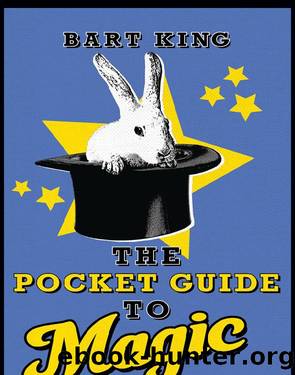The Pocket Guide to Magic by Bart King

Author:Bart King
Language: eng
Format: epub, mobi
ISBN: 9781423606376
Publisher: Gibbs Smith
Published: 2010-06-07T00:00:00+00:00
Fortune-
Telling
âLAST NIGHT I STAYED UP LATE PLAYING POKER WITH TAROT CARDS. I GOT A FULL HOUSE AND FOUR PEOPLE DIED.ââSteven Wright
The world is full of surprises, both pleasant and horrible. Why, at any point you might unexpectedly lose your house keys . . . or find mine. (Where are they?) How can we prepare ourselves for lifeâs unexpected events? Yes, I could always put my keys in the same place when I get home, thanks. But I could also turn to one of the countless âmagicalâ ways we humans have invented for trying to foresee the future.
For instance, thereâs an entire type of fortune-telling devoted to looking into reflective surfaces like crystal balls, mirrors, and pools. Called âscrying,â these methods supposedly reveal visions of the past and future, and even look into the spirit world. (Hey, if you foresaw an overhead shot of yourself knocking over a glass of milk, youâd be scrying over spilled milk!) Itâs a time-honored method; in Guatemala, ancient Mayans stared into small crystals called ilbâalâ âdevice for seeing.â
Starting in the Middle Ages, seers and Gypsies began gazing into large polished crystal balls, which were packed in black silk when not in use. The most famous crystal ball enthusiast was John Dee (1527â1608), the astrologer to Queen Elizabeth. And if you think nobody takes scrying seriously anymore, the current Dalai Lama was selected by a group of Buddhist monks who âdiscoveredâ his identity while looking into a Tibetan lake.
Tibet is currently part of China (what a rip-off!), and the I Ching (ee-jing, a.k.a., The Book of Changes) is Chinaâs contribution to fortune-telling. With a tradition going back thousands of years, itâs probably the oldest method of fortune-telling still practiced. Confucius used his copy of the I Ching so much, he wore out its binding three times! Anyway, the way it works involves fifty sticks and a complex set of maneuvers. This leads one to look up a section in the I Ching. The book features short sayings with a high moral tone, so the user might read âMoving onward with integrity brings good fortuneâ or âThose opposed to righteousness meet with harm.â1
Cuppa Tea?
If youâve heard of âreading tea leaves,â you know that fortune-telling can be done in the comfort of your own kitchen. Iâd still have to hire a fortune-teller to read the tea leaves for me. (I stare and stare at them but canât make out any letters.)
Tea-leaf reading (or tasseomancy) began in China sometime during the sixth century. (No one in the West even knew what tea was then!) If you want to try it, make a cup of loose-leaf tea. Drink MOST of the tea, and then turn the cup around three times. Next, tip the cup upside down, turn it once more, make a wish, and blow out the candles. (Oops, wrong event!) At this point the cup is lifted up and examined. Tea leaves stuck at the cupâs bottom tell of the future, chunks near the rim are today, and chunks near the handle are most important.
Download
This site does not store any files on its server. We only index and link to content provided by other sites. Please contact the content providers to delete copyright contents if any and email us, we'll remove relevant links or contents immediately.
Kathy Andrews Collection by Kathy Andrews(11688)
The remains of the day by Kazuo Ishiguro(8759)
Paper Towns by Green John(5030)
Spare by Prince Harry The Duke of Sussex(5004)
The Body: A Guide for Occupants by Bill Bryson(4893)
Industrial Automation from Scratch: A hands-on guide to using sensors, actuators, PLCs, HMIs, and SCADA to automate industrial processes by Olushola Akande(4855)
Machine Learning at Scale with H2O by Gregory Keys | David Whiting(3982)
Be in a Treehouse by Pete Nelson(3881)
Harry Potter and the Goblet Of Fire by J.K. Rowling(3746)
Never by Ken Follett(3712)
Goodbye Paradise(3672)
Into Thin Air by Jon Krakauer(3268)
The Remains of the Day by Kazuo Ishiguro(3260)
The Cellar by Natasha Preston(3225)
The Genius of Japanese Carpentry by Azby Brown(3199)
Fairy Tale by Stephen King(3163)
120 Days of Sodom by Marquis de Sade(3124)
Drawing Shortcuts: Developing Quick Drawing Skills Using Today's Technology by Leggitt Jim(2965)
The Man Who Died Twice by Richard Osman(2963)
